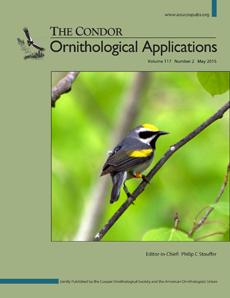Apr 30 2015
A pair of newly published papers in The Condor: Ornithological Applications lay out a method for outfitting birds with geolocators or radio transmitters that cuts precious weight from the package, allowing the devices to be used on very small birds, and demonstrate that the trackers do not harm the birds or impede their migration.
Henry Streby of the University of California, Berkeley, and Sean Peterson of the University of Minnesota led a team of researchers to carry out the studies, which could make it easier than ever before to identify the migratory routes and wintering ranges of small songbirds such as warblers.
 Golden-winged warblers, pictured here on the cover of the current issue of The Condor: Ornithological Applications, are the smallest birds yet to be outfitted with geolocators. Credit: Central Ornithology Publication Office
Golden-winged warblers, pictured here on the cover of the current issue of The Condor: Ornithological Applications, are the smallest birds yet to be outfitted with geolocators. Credit: Central Ornithology Publication Office
Unlike radio transmitters, which are best suited to tracking the movements of birds over relatively small areas, geolocators calculate a bird's position using sunrise and sunset times and can record their movements over an entire migratory cycle. Peterson, Streby, and their colleagues developed new methods for attaching both types of trackers to small birds, using harnesses made of elastic thread or jewelry cord that don't require metal or plastic parts and can be placed on the birds smoothly and quickly. "It took a lot of brainstorming and effort in the field to get things just right with transmitters on small songbirds. Once we had it working, we refined the method over several years, and then all of that knowledge translated smoothly to geolocators," says Streby.
Weighing just 8-10 grams each, Golden-winged Warblers (Vermivora chrysoptera) are the smallest birds yet to be outfitted with geolocators. The researchers captured 20 Golden-winged Warblers at each of two sites, one in Minnesota and one in Tennessee, in May 2013 and fitted them with geolocators using their new method. When the warblers returned to the following spring after having traveled over five thousand miles, geolocator-carrying birds did not differ significantly from control birds in return rate, migration timing, or body mass.
"I think one of the best things about working on this project was the feeling of excitement when one of our marked individuals returned," says Peterson. "When we analyzed the data and had the migration routes of these tiny birds laid out in front of us, it was just kind of awe-inspiring to think that they were making such an epic journey twice a year."